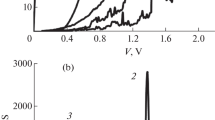Abstract
A new effect, called attenuated quantum confinement, is described using a theoretical approach, based on the effective mass approximation. It assumes that the exciton, generated in a semiconductor nanocrystal, can penetrate the medium outside the crystal boundary. An equation is derived for the energy of attenuated quantum confinement depending on the penetration depth and mass of exciton outside the crystalline core. It gives lower absorption energy, which is observed experimentally for very small nanocrystals, compared to that predicted by usual quantum confinement. The penetration depth calculated for compound semiconductors is found to be of the same magnitude as that of the thickness of organic capping layer for CdS, CdSe, PbS and InAs nanoparticles. Our finding can also explain other practical processes of charge generation and transportation in a matrix with embedded nanocrystals.





Similar content being viewed by others
References
Dabbousi BO, Rodriguez-Viejo J, Mikulec FV, Heine JR, Mattoussi H, Ober R, Jensen KF, Bawendi MG (1997) J Phys Chem B 101:9463
Efros AlL, Efros AL (1982) Sov Phys Semicond 16:772
Brus LE (1983) J Chem Phys 79:5566
Yoffe AD (1993) Adv Phys 42:173
Weller H, Schmidt HM, Koch U, Fojtik A, Baral S, Henglein A, Kunath W, Weiss K, Dieman E (1986) Chem Phys Lett 124:557
Wang Y, Herron N, Mahler W, Suna A (1989) J Opt Soc Am B 6:808
Murray CB, Norris DJ, Bawendi MG (1993) J Am Chem Soc 115:8706
Peng X, Wickham J, Alivisatos AP (1998) J Am Chem Soc 120:5343
Dushkin CD, Saita S, Yoshie K, Yamaguchi Y (2000) Adv Colloid Interface Sci 88:37
Nirmal M, Dabbousi BO, Bawendi MG, Macklin JJ, Trautman JK, Harris TD, Brus LE (1996) Nature 383:802
Masumoto Y (1996) J Luminescence 70:386
Maenosono S, Dushkin CD, Saita S, Yamaguchi Y (2000) Japan J Appl Phys Part 1 39:4006
Fojtik A, Weller H, Koch U, Henglein A (1984) Ber Bunsenges Phys Chem 88:969
Kittel C (1986) Introduction to solid state physics. Wiley, New York
Wang Y, Suna A, Mahler W, Kasowski R (1987) J Chem Phys 87:7315
Guzelian AA, Banin U, Kadavanich AV, Peng X, Alivisatos AP (1996) Appl Phys Lett 69:1432
Schlamp MC, Peng X, Alivisatos AP (1997) J Appl Phys 82:5837
Sze SM (1981) Physics of semiconductor devices. Wiley, New York
Author information
Authors and Affiliations
Rights and permissions
About this article
Cite this article
Dushkin, C., Papazova, K., Dushkina, N. et al. Attenuated quantum confinement of the exciton in semiconductor nanoparticles. Colloid Polym Sci 284, 80–85 (2005). https://doi.org/10.1007/s00396-005-1327-0
Received:
Accepted:
Published:
Issue Date:
DOI: https://doi.org/10.1007/s00396-005-1327-0




